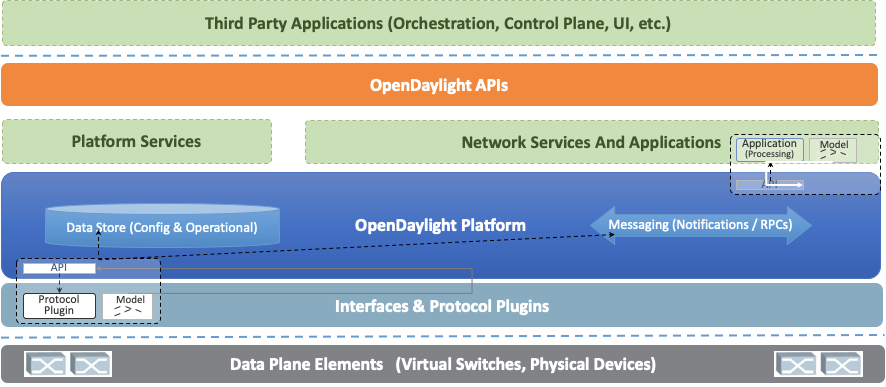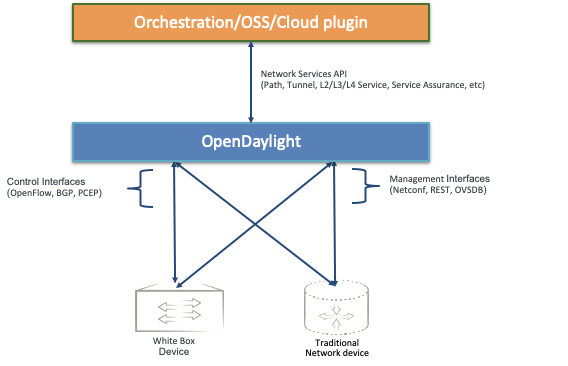...
Editor: Abhijit Kumbhare
Introduction
OpenDaylight (ODL) is a modular open platform for customizing and automating networks of any size and scale. The OpenDaylight Project arose out of the SDN movement, with a clear focus on network programmability. It was designed from the outset as a foundation for commercial solutions that address a variety of use cases in existing network environments.
OpenDaylight Architecture
Model-Driven
The core of the OpenDaylight platform is the Model-Driven Service Abstraction Layer (MD-SAL). In OpenDaylight, underlying network devices and network applications are all represented as objects, or models, whose interactions are processed within the SAL.
The SAL is a data exchange and adaptation mechanism between YANG models representing network devices and applications. The YANG models provide generalized descriptions of a device or application’s capabilities without requiring either to know the specific implementation details of the other. Within the SAL, models are simply defined by their respective roles in a given interaction. A “producer” model implements an API and provides the API’s data; a “consumer” model uses the API and consumes the API’s data. While ‘northbound’ and ‘southbound’ provide a network engineer’s view of the SAL, ‘consumer’ and ‘producer’ are more accurate descriptions of interactions within the SAL. For example, protocol plugin and its associated model can either be a producer of information about the underlying network, or a consumer of application instructions it receives via the SAL.
The SAL matches producers and consumers from its data stores and exchanges information. A consumer can find a provider that it’s interested in. A producer can generate notifications; a consumer can receive notifications and issue RPCs to get data from providers. A producer can insert data into SAL’s storage; a consumer can read data from SAL’s storage. A producer implements an API and provides the API’s data; a consumer uses the API and consumes the API’s data.
Modular and Multiprotocol
The ODL platform is designed to allow downstream users and solution providers maximum flexibility in building a controller to fit their needs. The modular design of the ODL platform allows anyone in the ODL ecosystem to leverage services created by others; to write and incorporate their own; and to share their work with others. ODL includes support for the broadest set of protocols in any SDN platform – OpenFlow, OVSDB, NETCONF, BGP and many more – that improve programmability of modern networks and solve a range of user needs.
Southbound protocols and control plane services, anchored by the MD-SAL, can be individually selected or written, and packaged together according to the requirements of a given use case. A controller package is built around four key components (odlparent, controller, MD-SAL and yangtools). To this, the solution developer adds a relevant group of southbound protocols plugins, most or all of the standard control plane functions, and some select number of embedded and external controller applications, managed by policy.
Each of these components is isolated as a Karaf feature, to ensure that new work doesn’t interfere with mature, tested code. OpenDaylight uses OSGi and Maven to build a package that manages these Karaf features and their interactions.
This modular framework allows developers and users to:
- Only install the protocols and services they need
- Combine multiple services and protocols to solve more complex problems as needs arise
- Incrementally and collaboratively evolve the capabilities of the open source platform
- Quickly develop custom, value-added features for highly specialized use cases, leveraging a common platform shared across the industry.
Bottomline about the Architecture
...
As we saw, the OpenDaylight platform (ODL) provides a flexible common platform underpinning a wide variety of applications and Use Cases. Some of the most common use cases are mentioned here - but OpenDaylight platform can be used in several other use cases not mentioned here.
ONAP
The SDN Controller (SDNC) and the Application Controller (APPC) components of ONAP are based on OpenDaylight.
...
OpenDaylight can expose Network Services API for northbound applications for Network Automation in a multi vendor network.
These are just a few of the common use cases but the platform can and continues to be tailored to several other use cases.
3.4 Open Switch
Editor: Mike Lazar
...

